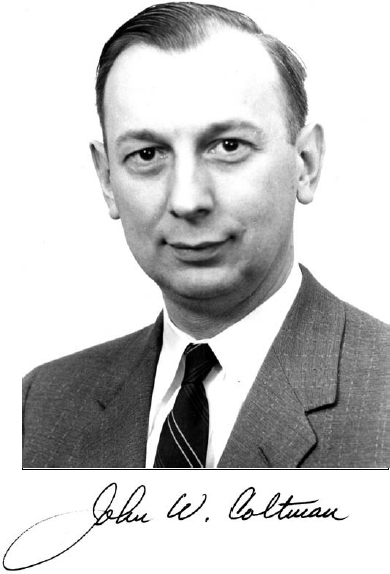1915–2010
Elected in 1976
“For pioneering advancements in X-ray and low-light level imaging devices,
undersea equipment, and electron tubes.”
BY MAURY FEY
SUBMITTED BY THE HOME SECRETARY
JOHN W. COLTMAN, physicist and retired research executive of Westinghouse Electric Corporation, died February 10, 2010.
John W. Coltman was born in Cleveland on July 15, 1915. His father was an analytical chemist with the National Carbon Company (which became part of Union Carbide). He obtained his B.S. degree in physics from Case School of Applied Science (now Case Western Reserve University) in 1937 and an M.S. in physics and a Ph.D. in nuclear physics from the University of Illinois in 1941. That same year he was married to Charlotte Coltman of Urbana, Illinois, and they moved to Pittsburgh, Pennsylvania, where he joined Westinghouse Research Laboratories.
During World War II, Dr. Coltman did research in microwave tubes for use in radar and jamming enemy radar. Later, he took charge of a group of scientists whose aim was to solve the problem of the extremely dim images then obtainable in medical fluoroscopy. The resulting development of the X-ray image amplifier provided a brightening of 500 times and revolutionized modern clinical fluoroscopy. It made possible the techniques of cine-fluorography, television fluoroscopy, digital angiography, and video X-ray recording. It is used in many surgical procedures and today is still standard
equipment in every hospital radiology department. Work on this device also resulted in the scintillation counter, of which Dr. Coltman was coinventor.
In 1949, Dr. Coltman was named manager of the electronics and nuclear physics department. He became responsible for research programs in acoustics, information theory, infrared, underwater sound, nuclear physics, optical pickup tubes, semiconductor devices, and television. In 1960 he was named associate director of the research laboratory, responsible for a group of several departments. In 1969, Dr. Coltman was appointed research director for the Public Systems Company and later director of R&D planning for Westinghouse’s Research and Development Center, the position from which he retired in 1980. He held 22 patents and wrote 66 technical articles and chapters in three books.
Ever since his school days, Dr. Coltman played the flute. He was associate director of the Wilkinsburg Symphony Orchestra and played in the Pittsburgh Woodwind Quintet. His interest in flute led him to research on its acoustics, carried out in his home laboratory. He published some 40 articles on musical acoustics and was a recognized authority on the acoustics of the flute. Among his other pursuits were sailing, woodworking, and amateur radio, for which he was first licensed in 1932.
Many honors came to Dr. Coltman. He was elected a fellow of both the Institute of Electrical and Electronics Engineers and the American Physical Society. He served on many committees of the U.S. government and was a member of the National Research Council’s Commission on Human Resources. In 1960, Dr. Coltman received the Longstreth Medal of the Franklin Institute for his development of the X-ray image amplifier and was also named Pittsburgh’s Man of the Year in Science by the Junior Chamber of Commerce. In 1968 he was awarded the Westinghouse Order of Merit, not only for the X-ray amplifier and scintillation counter but also for his pioneering contributions to the infant science of radar in the 1940s and his later work on undersea equipment and electron tubes, including television. In 1970 he was awarded the Roentgen Medal by the Roentgen Museum in Germany, and in 1976
he was elected to the National Academy of Engineering. In 1982 he received the Gold Medal of the Radiological Society of North America in recognition of the development of the X-ray image amplifier.
Dr. Coltman is survived by his wife Charlotte of Strongsville, Ohio; their daughters, Sally Condit, also of Strongsville, and Nancy Horner of Severn, Maryland; four grandchildren; and four great-grandchildren.





